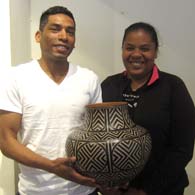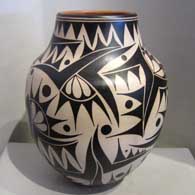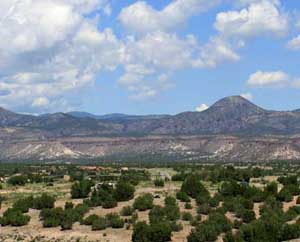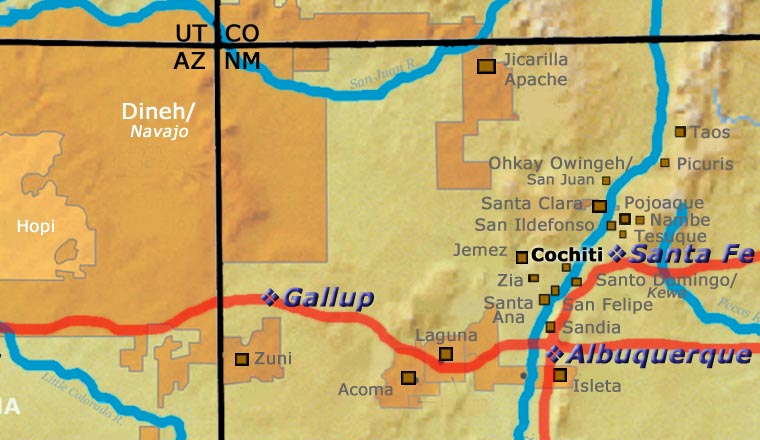
Lisa Holt & Harlan Reano
Cochiti/Santo Domingo


Half Cochiti (on her mother's side), Lisa Holt was born into a well-known multi-generational family of potters in 1980. Her grandmother is Seferina Ortiz, her mother Juanita Ortiz and her uncle Virgil Ortiz. Lisa has been making pottery since 1999 and specialized in creating human and animal forms, following long Cochiti tradition. These days she's been making large beautiful ollas. She makes all her pots the traditional way: by hand-coiling the forms from materials she processes herself.
Born in 1976, Harlan Reano is from Santo Domingo Pueblo. He uses Lisa's elegant forms and figures as a three-dimensional "canvas" for his boldly painted designs that range from traditional geometrics to stylized graffiti patterns. Together, they complete the process by ground firing their innovative and dynamic creations.
Since their debut in 2001, they have pushed the shape and design envelope of contemporary Pueblo pottery with their work. Harlan revived historic Santo Domingo designs in 2003 and by 2004 he was creating more elaborate "twisted" shapes and figures. After only four years, they were considered "rising stars" among Native American potters and were beginning to win major awards at the Heard Museum Market and the SWAIA Santa Fe Indian Market. Every year since they have continued to win awards and accolades for their pottery in addition to being featured in several books and magazines on contemporary Pueblo pottery. Their innovations in design and form have captivated many traders and collectors and continue to inspire other artists. Their work has attracted museum attention and continues to expand the national and international audience for Pueblo pottery.
100 West San Francisco Street, Santa Fe, New Mexico 87501
(505) 986-1234 - www.andreafisherpottery.com - All Rights Reserved

Cochiti Pueblo

View west across Cochiti Pueblo
Cochiti Pueblo lies fifteen miles south of Santa Fe along the west bank of the Rio Grande. Frijoles Canyon in what is now Bandelier National Monument is the site of the pueblo's most recent ancestral home. The Eastern Keresans may have relocated to the Bandelier area from the Four Corners region around 1300.
Cochiti legend says that Clay Old Woman and Clay Old Man came to visit the Cochitis. While all the people watched, Clay Old Woman shaped a pot. Clay Old Man danced too close and kicked the pot. He rolled the clay from the broken pot into a ball, gave a piece to all the women in the village and told them never to forget to make pottery.

At Bandelier National Monument
In prehistoric times, human effigy pots, animals, duck canteens and bird shaped pitchers with beaks as spouts were common productions of the Cochiti potters. Many of these were condemned as idols and destroyed by the Franciscan priests. That problem stopped when the Spanish left in 1820 but the fantastic array of figurines created by Cochiti potters was essentially dormant until the railroad arrived. Then Cochiti potters were among the first to enter the tourist market and they produced many whimsical figures into the early 1900s. Then production followed the market into more conventional shapes.
Legend has it that a Ringling Brothers Circus train broke down near Cochiti Pueblo in the 1920s. Supposedly, the tribe's contact with the ringmaster, trapeze artists, opera singers, sideshow "freaks" and exotic animals paved the way for a variety of new figural subjects. However, shortly after the railroad passed through, a delegation of Cochiti men got on the train and traveled to Washington DC. There they were introduced to the President, spoke to Congress, and were taken on a tour of the "highlights" of American civilization in Washington and in New York City, incuding the Metropolitan Opera, the Bronx Zoo and a performance of the Ringling Brothers Circus. As none of the men could read or write, nor draw, what they brought back to Cochiti was what they remembered of things they had never seen before. The stories they told must have been wild. An astute observer will find angels, nativities, cowboys, tourist caricatures, snakes, dinosaurs, turtles, goats, two-headed opera singers, clowns, tattooed strongmen, Moorish nuns and even mermaids in the Cochiti pottery pantheon, many produced only since the early 1960s and based on characters described in Cochiti's oral history.
A few modern potters make traditional styled pots with black and red flowers, animals, clouds, lightning and geometric designs but most Cochiti pottery artists now create figurines. Most notable is the storyteller, a grandfather or grandmother figure with "babies" perched on it. Helen Cordero is credited with creating the first storyteller in 1964 to honor her grandfather. The storyteller style was quickly picked up by other pueblos and each modified the form to match their local situation (ie: clay colors and tribal and religious traditions). In some pueblos, storytellers are also now made as drummers and as a large variety of animals.
Today, Cochiti potters face the challenge of acquiring the clay for the white slip. Construction of Cochiti Dam in the 1960s destroyed their primary source of their trademark white slip and gray clay. Now the white slip comes from one dwindling source at Santo Domingo, Cochiti Pueblo's neighbor to the south.
Most outsiders who visit Cochiti Pueblo these days do so on the way to or from either the recreation area on Cochiti Lake or Kasha-Katuwe Tent Rocks National Monument.
100 West San Francisco Street, Santa Fe, New Mexico 87501
(505) 986-1234 - www.andreafisherpottery.com - All Rights Reserved

Laurencita Herrera Family Tree
Disclaimer: This "family tree" is a best effort on our part to determine who the potters are in this family and arrange them in a generational order. The general information available is questionable so we have tried to show each of these diagrams to living members of each family to get their input and approval, too. This diagram is subject to change should we get better info.
-
Laurencita Herrera (1912-1984) & Nestor Herrera
- Mary Frances Herrera (1935-1991)
- Dorothy Herrera (1969-)
- Edwin Herrera (1966-) & Mary Herrera
- Mary Ramona Herrera (1970-)
- Seferina Ortiz (1931-2007) & Guadalupe Ortiz
- Joyce Ortiz Lewis (1954-)
- Leslie Lewis
- Mary Janice Ortiz (1956-)
- Kimberly Walker (1978-)
- Juanita Inez Ortiz (1960-2008)
- Krystal Ortiz (1987-)
- Lisa Holt (1980-) & Harlan Reano (1976-)(Santo Domingo)
- Dominique Reano
- Virgil Ortiz (1969-)
- Leon Ortiz & Jackie Ortiz
- Amanda Ortiz (1988-)
- Joyce Ortiz Lewis (1954-)
Some of the above info is drawn from Southern Pueblo Pottery, 2000 Artist Biographies, by Gregory Schaaf, © 2002, Center for Indigenous Arts & Studies
Other info is derived from personal contacts with family members and through interminable searches of the Internet and cross-examination of the data found.
(505) 986-1234 - www.andreafisherpottery.com - All Rights Reserved
